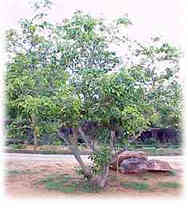PUNGAM (OR) KARANJA

Botanical Name : Pongamia pinnata (L), Derris indica (Lam.), Pongamia glabra Vent.
Family : Fabaceae (Papilionaceae)
Distribution
This tree can be seen in the greater part of India in- the plains from Ravi eastwards growing along rivers and up creeks in the peninsula. It is found in Uttar-Pradesh, Bihar, Orissa, Madhya Pradesh, Andhra Pradesh, Karnataka, Tamil Nadu and Kerala. It.aJso grows wild in the tidal and beach forests of sunderbans and along stream banks as in the dunes of the seashore as in Andaman. It can also be seen as a cultivated species along canal banks, roadside avenues and along bunds.
Environmental requirement
Temperature
In its natural habitat, the maximum temperature ranges from 27 to 38°C and the minimum 1 to16°C.
Rainfall
Pungam is native to humid and subtropical environments and thrives in areas having an annual rainfall at 500 - 2500 mm.
Topography
This species grows up to an elevation of 1200 m but in the Himalaya foothills is not found above 600 m.
Soil Requirement
Pungam can grow on most soil types ranging from stony to sandy to clayey, including verticals. It does not do well on dry sands. It is highly tolerant to salinity. It is common along waterways or seashore with its roots in fresh or salt water. Highest growth rates are observed on well drained soil with assured moisture.
Phenology
The tree exhibits considerable variation in its phenological habits. It is evergreen in favorable conditions and completely leafless, .between March and May under adverse condition. Fresh leaves and flowers appear immediately. Flower appears from April to July. Pods appear from January to March. The tree starts flowing and setting pods from the 4 to 7 years.
Silvicultural Characters
Light - It is a light demander but can tolerant shade.
Frost - Susceptible to severe frost
Drought - It is a drought hardy species to certain extent
Flood - It can also tolerate high moisture for a short period.
Coppicing - It is a excellent coppicer
Root suckers-It can also produce root suckers readily.
Pollarding - It can withstand pollarding.
Silviculture
Natural Regeneration
It regenerates profusely from seeds in nature under frost condition. The tree naturally coppicing well and sends out root suckers in natural conditions.
Artificial Regeneration
The treejs easily established'by direct seedling or by planting nursery raised seedling or stump cuttings of 1 - 2 cm root - .collar diameter. Propagation by branch cutting and root suckers is also possible. Fresh seeds yield high germination. Tree will yield about 10-5.0 kg of seeds. About 1500-1700 seeds weigh are kilogram. Seeds require no treatment before sowing and will remain viable from one year if storedlnside the pod in containers free from pest and disease attack.
Nursery Practice
Fresh seeds are sown directly in polybags of 20 x 15 cm filled with soil, sand and FYM in the ratio of 2:1:1. Seeds germinate,in 10-15 days. Seeds with unknown germination can be sown in mother beds and then transplanted into polybags after germination at 30 - 40 days. This will help to overcome empty polybags and get uniform seedlings in nursery.
Planting
Seedlings of six months to one year old are outplanted in the main field into pits of 30 cm3 or 45 cm3 at 3mx3mor5mx5m spacing. Application of FYM 5 kg, DAP 25 g per pit will enhance growth and establishment.
Maintenance and After Care
Watering - In dry localities watering during the summer months for the first two years will give high survival percentage and good growth.
Tending operation - Weeding around the plant for the first three years will ensure good growth. As avenue or garden tree pruning have to be done to get a proper bole.
Yield - Mainly grow for its pod which yields oil of 20-25 per cent. A well grown up tree of 5-10 years can yield 10-50 kg of seeds per tree.
Uses - Wood is not considered as a quality timber. It is used for cabinet making, cart wheels, agricultural implements, and tool handles. The leaves contain 18% crude protein and is eaten by cattle and goats. Oil is used as fuel for cooking and lamps and also as a bio-diesel. The oil cake is used in poultry feed. Dried leaves are used as an insect repellent in stored grains. |

